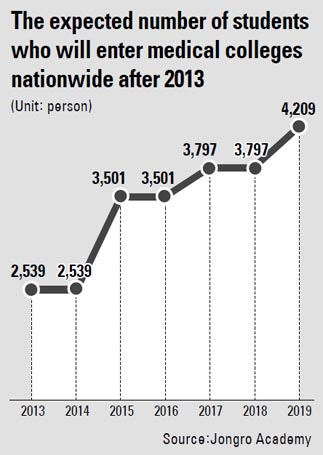Students aiming for medical schools

In Korea, sophomores in high school can choose between two different curriculum tracks: natural sciences or liberal arts. Students on the natural science track can apply for medical or engineering colleges while those studying liberal arts apply for schools offering majors in the humanities or business.
“My son, whose grades are usually at the top of the class, wants to study business administration, which requires him to study liberal arts,” says a 51-year-old mother surnamed Park, who has a 16-year-old son.
“But I think it would be better for him to select natural science so he can be a doctor, which is a stable job. I also heard that some elite universities prefer students on the natural sciences track.”
By 2019, medical colleges will accept twice as many students as they do now, according to universities nationwide.
This year, about 2,300 students who take the College Scholastic Ability Test will gain admission to medical colleges. In 2015 the number will rise to 3,500, and in 2019 it will reach 4,200.
Most medical colleges, 22 out of 27, announced in November 2010 that they will abolish the so-called “medical schools for doctorate degree” program launched by the Roh Moo-hyun administration in 2005. That program allowed students who majored in the liberal arts to get doctorates in medicine and become doctors. Those schools will revert to the old system in which doctors must have a bachelor’s degree from a four-year medical college.
Since 2010, 11 medical colleges have increased their quota for bachelor’s degree candidates, up to 70 percent for freshmen in 2015.
“Statistically, students on natural science tracks are likely to get admission to elite universities more easily than those studying liberal arts,” said Jo Je-hyeon, vice-principal of Sorabol High School in Seoul. “Many students with top grades are now focusing on entering medical colleges due to the increased quotas.”
According to educational consultants, the number of students who took the natural science CSAT in 2010 was 7,017 more than in 2009, and the number of students who took the social sciences CSAT dipped 9,888 from 2009.
By Kim Sung-tak, Kim Hee-jin [heejin@joongang.co.kr]
한글 관련 기사 [중앙일보]
의·치대 정원 2배로…이과로 몰린다
의학전문대학원 → 의대 전환
고2생 대입부터 순차적 증원
지금 중3 입시 땐 3500명 뽑아
고1 아들을 둔 박모(51)씨는 벌써부터 내년에 아들을 문과·이과 중 어느 쪽을 선택하게 해야 할지 고민 중이다.
아들이 대학 입시를 치를 때면 의대 정원이 늘어난다는 소식을 들어서다. 박씨는 “아이는 경영학과를 가고 싶다는데 직업 안정성을 따지면 이과로 가 의대에 진학했으면 좋겠다”고 말했다.
현재 고2가 치르는 2013학년도 대입부터 의·치대 모집정원이 늘어난다. 2019학년도 정원은 올해보다 두 배로 늘어날 전망이어서 학생·학부모들의 ‘이과 선호’ 움직임이 일고 있다. 올해 고3이 치르는 2012학년도 입시에서는 의·치·한의예과 선발 인원이 지난해와 같다. 의예과 1371명, 치의예과 220명, 한의예과 750명 등 2300여 명이다. 종로학원의 분석에 따르면 내년에는 2539명으로 증가할 전망이다. 의학전문대학원(의전원)이 순차적으로 의대로 전환되기 때문이다.
학부와 의전원으로 나눠 선발해 온 서울대·고려대·연세대 등 11개 대학이 2013학년도부터 학부생을 전체 모집정원의 70%까지 뽑는다. 치대·치의학전문대학원 병행 대학도 마찬가지다.
현재 중3이 치르는 2015학년도 대입에선 의전원만 운영하는 11개 대학이 70%를 학부생으로 뽑기 시작한다. 의·치·한의예과 정원만 3500명에 달한다. 의대 전환이 완료되는 2019학년도에는 선발 규모가 4209명으로 늘어난다.
그러자 이과가 인기를 끌 조짐이다. 서울 노원구 서라벌고의 경우 2월 졸업생은 문·이과 반이 9개씩이었으나, 현재 고2는 문과(7개 반)보다 이과(11개 반)가 많다. 조재현 서라벌고 교감은 “문과생 전체 규모가 워낙 커 이과생의 상위권 대학 진학률이 높다”며 “상위권 학생들은 의대 정원 증가를 염두에 두는 것 같다”고 말했다.
이과 선호 현상은 고3에서도 나타났다. 지난달 10일 치러진 고3 전국연합학력평가 결과 사회탐구 응시자는 지난해보다 9888명 줄고 과학탐구는 7017명 증가했다. 이과생이 주로 보는 수리 가형은 지난해보다 6000명 늘어났는데, 수리 나형은 7000명 감소했다. 이투스청솔 오종운 평가이사는 “수리 나형 시험범위에 미적분이 포함되면서 이과를 택한 수험생이 많아진 것 같다”고 분석했다.










with the Korea JoongAng Daily
To write comments, please log in to one of the accounts.
Standards Board Policy (0/250자)